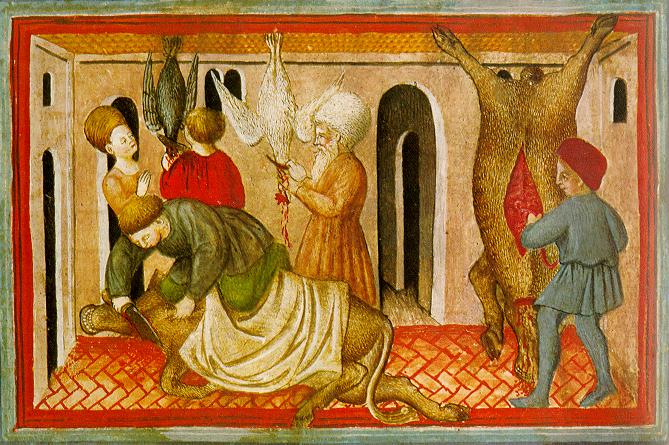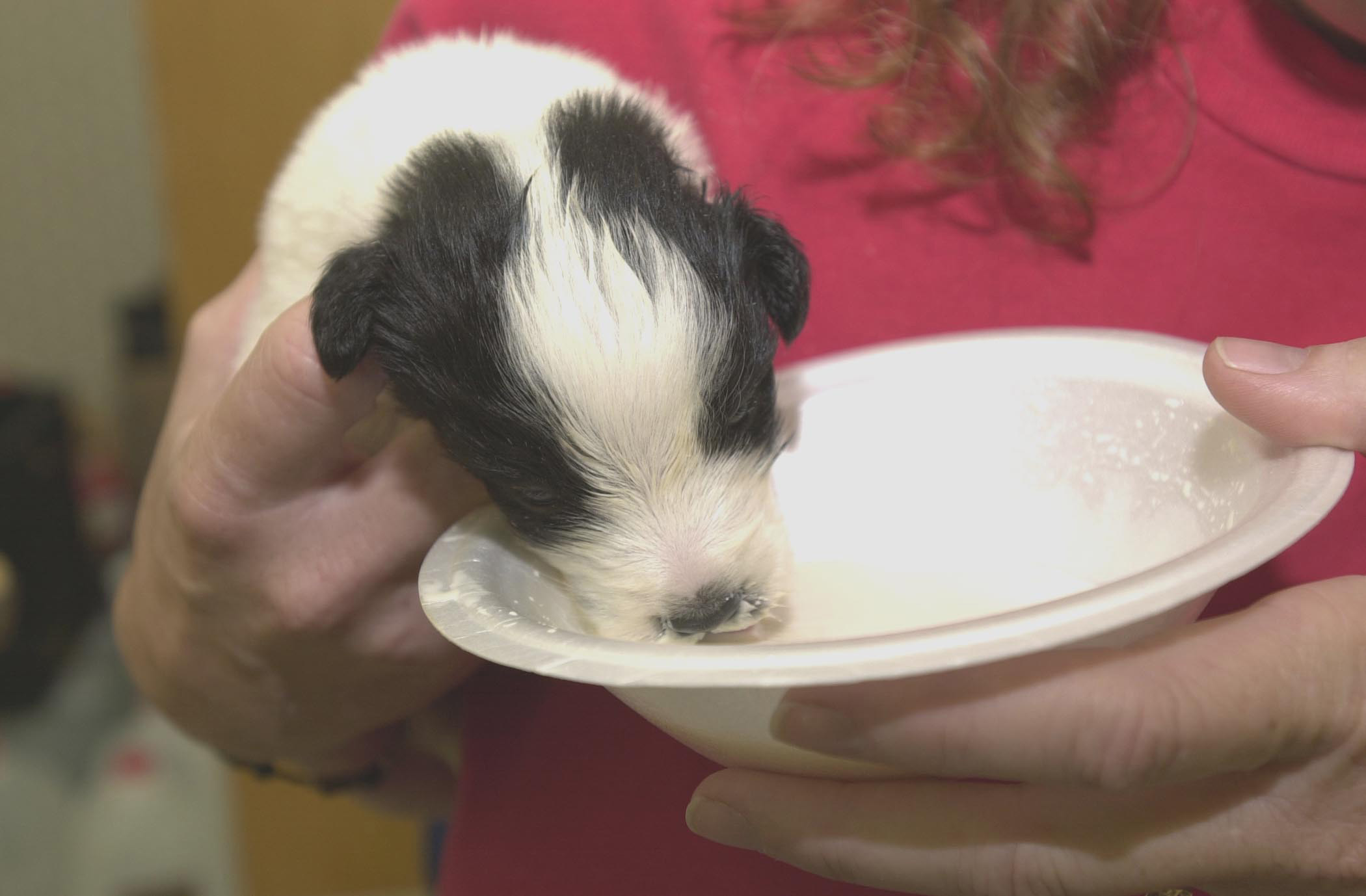|
Pithing
Pithing is a technique used to immobilize or kill an animal by inserting a needle or metal rod into its brain. It is regarded as a humane means of immobilizing small animals being observed in experiments, and while once common in commercial slaughtering is no longer practiced in some developed countries on animals intended for the human food supply due to the risks of embedded metal fragments and general spread of disease. Current United States and European Union regulations prohibit importation of beef from cows pithed due to risk of bovine spongiform encephalopathy (BSE, also known as mad cow disease). It is, however, encouraged for animals in emergency or specific disease control situations where the meat will not be consumed. Use Commercial slaughter An animal is first immobilized through captive bolt stunning. A pithing cane or rod is then inserted into the stunning hole and pushed to its full length; the rod then remains locked in the hole and is disposed of with the ani ... [...More Info...] [...Related Items...] OR: [Wikipedia] [Google] [Baidu] |
Ikejime
or is a method of killing fish that maintains the quality of its meat. The technique originated in Japan, but is now in widespread use. It involves the insertion of a spike quickly and directly into the hindbrain, usually located slightly behind and above the eye, thereby causing immediate brain death. After spiking the brain, a thin needle or piece of wire is inserted into the spinal columns neural canal to prevent any further muscle movement. When spiked correctly, the fish fins flare and the fish relaxes, immediately ceasing all motion. Destroying the brain and the spinal cord of the fish will prevent reflex action from happening; such muscle movements would otherwise consume adenosine triphosphate (ATP) in the muscle, and as a result produce lactic acid and ammonia, making the fish sour, soggy and less tasteful. Furthermore, the blood contained in the fish flesh retracts to the gut cavity, which produces a better coloured and flavoured fillet, and prolongs shelf life. This m ... [...More Info...] [...Related Items...] OR: [Wikipedia] [Google] [Baidu] |
Brain
The brain is an organ (biology), organ that serves as the center of the nervous system in all vertebrate and most invertebrate animals. It consists of nervous tissue and is typically located in the head (cephalization), usually near organs for special senses such as visual perception, vision, hearing, and olfaction. Being the most specialized organ, it is responsible for receiving information from the sensory nervous system, processing that information (thought, cognition, and intelligence) and the coordination of motor control (muscle activity and endocrine system). While invertebrate brains arise from paired segmental ganglia (each of which is only responsible for the respective segmentation (biology), body segment) of the ventral nerve cord, vertebrate brains develop axially from the midline dorsal nerve cord as a brain vesicle, vesicular enlargement at the rostral (anatomical term), rostral end of the neural tube, with centralized control over all body segments. All vertebr ... [...More Info...] [...Related Items...] OR: [Wikipedia] [Google] [Baidu] |
Slaughterhouse
In livestock agriculture and the meat industry, a slaughterhouse, also called an abattoir (), is a facility where livestock animals are slaughtered to provide food. Slaughterhouses supply meat, which then becomes the responsibility of a meat-packing facility. Slaughterhouses that produce meat that is not intended for human consumption are sometimes referred to as ''knacker's yards'' or ''knackeries''. This is where animals are slaughtered that are not fit for human consumption or that can no longer work on a farm, such as retired work horses. Slaughtering animals on a large scale poses significant issues in terms of logistics, animal welfare, and the environment, and the process must meet public health requirements. Due to public aversion in different cultures, determining where to build slaughterhouses is also a matter of some consideration. Frequently, animal rights groups raise concerns about the methods of transport to and from slaughterhouses, preparation prior to s ... [...More Info...] [...Related Items...] OR: [Wikipedia] [Google] [Baidu] |
European Union
The European Union (EU) is a supranational union, supranational political union, political and economic union of Member state of the European Union, member states that are Geography of the European Union, located primarily in Europe. The union has a total area of and an estimated population of over 449million as of 2024. The EU is often described as a ''sui generis'' political entity combining characteristics of both a federation and a confederation. Containing 5.5% of the world population in 2023, EU member states generated a nominal gross domestic product (GDP) of around €17.935 trillion in 2024, accounting for approximately one sixth of global economic output. Its cornerstone, the European Union Customs Union, Customs Union, paved the way to establishing European Single Market, an internal single market based on standardised European Union law, legal framework and legislation that applies in all member states in those matters, and only those matters, where the states ... [...More Info...] [...Related Items...] OR: [Wikipedia] [Google] [Baidu] |
Bovine Spongiform Encephalopathy
Bovine spongiform encephalopathy (BSE), commonly known as mad cow disease, is an incurable and always fatal neurodegenerative disease of cattle. Symptoms include abnormal behavior, trouble walking, and weight loss. Later in the course of the disease, the cow becomes unable to function normally. There is conflicting information about the time between infection and onset of symptoms. In 2002, the World Health Organization suggested it to be approximately four to five years. Time from onset of symptoms to death is generally weeks to months. Spread to humans is believed to result in variant Creutzfeldt–Jakob disease (vCJD). , a total of 233 cases of vCJD had been reported globally. BSE is thought to be due to an infection by a misfolded protein, known as a prion. Cattle are believed to have been infected by being fed meat-and-bone meal that contained either the remains of cattle who spontaneously developed the disease or scrapie-infected sheep products. The United Kingdo ... [...More Info...] [...Related Items...] OR: [Wikipedia] [Google] [Baidu] |
Captive Bolt Pistol
A captive bolt pistol (also known as a captive bolt gun, a cattle gun, a stunbolt gun, a bolt gun, a stun gun and a stunner) is a device used for the stunning of animals prior to slaughter. A captive bolt pistol is intended to deliver a single, powerful strike to the forehead of an animal in order to quickly induce unconsciousness. Depending on the variation and usage, the bolt may or may not penetrate the skull and cause direct damage to the brain. The bolt consists of a heavy rod or piston, typically made of a corrosion-resistant material such as stainless steel. The bolt is actuated by a trigger pull and is propelled forward by either compressed air, a spring mechanism, or by the discharge of a blank round. After moving a short distance, spring tension causes the bolt to recoil back into the barrel. The captive bolt pistol was invented in 1903 by Hugo Heiss, the former director of a slaughterhouse in Straubing, Germany. Variations Captive bolt pistols are of three typ ... [...More Info...] [...Related Items...] OR: [Wikipedia] [Google] [Baidu] |
Spinal Cord
The spinal cord is a long, thin, tubular structure made up of nervous tissue that extends from the medulla oblongata in the lower brainstem to the lumbar region of the vertebral column (backbone) of vertebrate animals. The center of the spinal cord is hollow and contains a structure called the central canal, which contains cerebrospinal fluid. The spinal cord is also covered by meninges and enclosed by the neural arches. Together, the brain and spinal cord make up the central nervous system. In humans, the spinal cord is a continuation of the brainstem and anatomically begins at the occipital bone, passing out of the foramen magnum and then enters the spinal canal at the beginning of the cervical vertebrae. The spinal cord extends down to between the first and second lumbar vertebrae, where it tapers to become the cauda equina. The enclosing bony vertebral column protects the relatively shorter spinal cord. It is around long in adult men and around long in adult women. The diam ... [...More Info...] [...Related Items...] OR: [Wikipedia] [Google] [Baidu] |
Exsanguination
Exsanguination is the loss of blood from the circulatory system of a vertebrate, usually leading to death. The word comes from the Latin 'sanguis', meaning blood, and the prefix 'ex-', meaning 'out of'. Exsanguination has long been used as a method of animal slaughter. Humane slaughter must ensure the animal is rendered insensible to pain, whether through a captive bolt or other process, prior to the bloodletting. Depending upon the health of the individual, a person usually dies from losing half to two-thirds of their blood; a loss of roughly one-third of the blood volume is Critical condition, considered very serious. Even a single deep cut can warrant Surgical suture, suturing and Inpatient care, hospitalization, especially if Trauma (medicine), trauma, a vein or artery, or another comorbidity is involved. In the past, bloodletting was a common medical procedure or therapy, now rarely used in medicine. Slaughtering of animals Exsanguination is used as a Animal slaughter, s ... [...More Info...] [...Related Items...] OR: [Wikipedia] [Google] [Baidu] |
Animal Welfare
Animal welfare is the quality of life and overall well-being of animals. Formal standards of animal welfare vary between contexts, but are debated mostly by animal welfare groups, legislators, and academics. Animal welfare science uses measures such as longevity, disease, immunosuppression, ethology, behavior, physiology, and reproduction, although there is debate about which of these best indicate animal welfare. Respect for animal welfare is often based on the belief that nonhuman animals are Sentience, sentient and that consideration should be given to their well-being or suffering, especially when they are under the care of humans. These concerns can include how animals are Animal slaughter, slaughtered for food, how they are used in Animal testing, scientific research, how they are kept (as pets, in zoos, farms, circuses, etc.), and how human activities affect the welfare and survival of wild species. There are two forms of criticism of the concept of animal welfare, comin ... [...More Info...] [...Related Items...] OR: [Wikipedia] [Google] [Baidu] |







